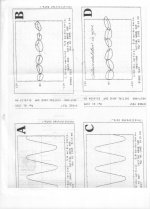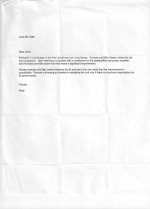As for the Bybee devices, they seem to drop in every now and then. I still don't see the point. Most people here probably have an oscilloscope of some kind, so I don't see why doesn't someone take two shots, one "as is" depicting noise components coming in from the grid, and another after passing the same via the Bybee device. If it shows a change, as in having less noise after the Bybee, then it's doing something, not just sitting there. I haven't even seen it, let alone tried it, so I can't comment, but if I doubted it, what I said would be what I'd do. Sales talk notwithstanding.
I have done all those things on ac power lines... voltage and currents and filtering. Would do so now if I had a Bybee thingy. I suggested JC do similar tests and show us. If no one does it and I cant get hold of a BYBee then lets just forget about it.
THx-RNMarsh
You confuse respect with 'believing without critical thinking'. I have a lot of respect for Richard and for his accomplishments. But if he (or you) says things that make no sense, I say so. I hope I would get respect for that.
Jan
Please do. And, you get respect for that...IF it is presented in a helpful manner. I have no financial stake in any of this nor ego. I am on a quest to find differences that could explain what I hear or think I hear in my digital portion of the system. Along the way, a lot of info that isnt in the books comes forth from experiences and tests etc. That is the really good stuff.
If I seem to not acknowledge an answer and keep asking the same question from various views, it is to get a lot more info... as does everyone viewing the forum. Sometimes some nice new info. If You were a manager of a group in R&D and doing some problem solving in a group meeting, you might ask each engineer what they think before making a decision and getting a group by-in. Remember, this is my background.... big systems thinking and big problems in physics/Engineering R&D.... I am not the consultant/expert that some are (or think they are).
I am also curious about how the ByBee would test on my network analyzer.
From the measurements i can determine what affects that Black Box will have.... but not about if it matters in listening..... that depends on the PSRR, EMI/RFI suppression and a whole host of thingsand that varies by system... so no concrete answer could be given. But deep, broadband filtering on the ac line will make a big difference in some systems which need it.
THx-RNMarsh
Last edited:
Ok, if my "Extraordinary claims" was what i said about feedback impedance influence on the closed loop bandwidth, a quick'n dirty simulation on a VFA .
If you agree that 1175/(1175+25000) = 47/(47+1000), you will agree the feedback ratio is the same. And as everything else is unchanged, open loop bandwidth unchanged.
Christophe,what about capacitance of the feedback input (Q1,Q2 bases)?
That's what i said from the beginning, as it seems the only possible explanation.Christophe,what about capacitance of the feedback input (Q1,Q2 bases)?
And we can see the effects of its non linearity on distortions:
20KHz
0.016162% (high impedance)
0.015488%
I have done all those things on ac power lines... voltage and currents and filtering. Would do so now if I had a Bybee thingy. I suggested JC do similar tests and show us. If no one does it and I cant get hold of a BYBee then lets just forget about it.
THx-RNMarsh
Glad to hear that, Richard, as I have a nagging feeling that far too many naysayers have not even tried any of that, they just "know" it's rip off. In my view, far too many "objectivists" here are very complacent regardig their own power supplies it seem nothing can improve on them, something I know to be false in my 12 year experience. If they can improve the sound of big Krells (and they can, I heard that with my own ears), why not of others too? Or am I asking for too much modesty? Why don't we find out?
I would suggest you try any power line device you can borrow, it would be interesting to compare their sales talk and promises with hard reality. But Bybees especially, since they were questioned harder than any other manufacturer. I realize I'm asking for a lot, but otherwise, one swallow doth not a spring make (nor a winter).
That's what i said from the beginning, as it seems the only possible explanation.
And we can see the effects of its non linearity on distortions:
20KHz
0.016162% (high impedance)
0.015488%
Er, Christophe? It would be helpful if you noted what the red and what the green colours denote, which is which.
Er, Christophe? It would be helpful if you noted what the red and what the green colours denote, which is which.
What's the number of the post that has the schematic?
Yes. 🙂 But unbalance the LTP ?If you will remove 470 Ohm from Q1 Q2 collectors, the difference might be much smaller
Last edited:
Oh, sorry, it seemed obvious to me: Corresponding colors are on the values of the feedback resistances on schematic.Er, Christophe? It would be helpful if you noted what the red and what the green colours denote, which is which.
Lower impedance= extended bandwidth.
What you're asking is a long-ago answered question. I did a comprehensive series of noise tests. Indistinguishable from a cheap resistor.Glad to hear that, Richard, as I have a nagging feeling that far too many naysayers have not even tried any of that, they just "know" it's rip off. In my view, far too many "objectivists" here are very complacent regardig their own power supplies it seem nothing can improve on them, something I know to be false in my 12 year experience. If they can improve the sound of big Krells (and they can, I heard that with my own ears), why not of others too? Or am I asking for too much modesty?
Richard, here is a test result done about 20 years ago at Ames near Moffett Field.
How many times does that one have to be knocked down before you stop trotting it out? I would have thought that you'd still be smarting from the last reaming that jneutron gave you.
It's what I have at the moment. Perhaps, I can do a similar test with this new product. I put this up for Richard. He may see it differently.
You don't count SY. You did NOT prove anything, except that your test equipment is limited.
You don't count SY. You did NOT prove anything, except that your test equipment is limited.
What you're asking is a long-ago answered question. I did a comprehensive series of noise tests. Indistinguishable from a cheap resistor.
I can hardly know what happened before I joined this thread. A link or some trace would be welcome.
What you're asking is a long-ago answered question. I did a comprehensive series of noise tests. Indistinguishable from a cheap resistor.
And, for the time and the units tested, it may well have been a very thorough and objective test. But no single test ever done by anybody is definitive. New devices are offered, and many different approaches are used, so many that it's really hard to expect anyone to do it all. My point is, what has already been done notwithstanding, perhaps it's time you revisited the topic. I for one would be interested to see what you find in a well organized test.
Guys, I hate to say it, but it is almost impossible to directly measure the noise output from a 0.025 ohm resistor, without a LOT of computer time. I also tried to measure a similar Bybee device with my ST analyzer (modified with AD797 IC inputs, and added signal averaging) and I did not find anything much either. I tend to use my ears, when all standard (limited) measurement fails.
Personally, I doubt that any of you out there will ever change your position on Bybee devices. Either you have tried them, and they worked for you, or they did not. Measurements would be interesting, if they showed anything new, but the test equipment, except for perhaps advanced AP or the SR-1, will not show anything generally. For me, listening is the key. I now have this unit back and I will listen to its effect on tubes, digital, and fets. This device is a little too far out for even me, but I do trust my ears.
Last edited:
- Status
- Not open for further replies.
- Home
- Member Areas
- The Lounge
- John Curl's Blowtorch preamplifier part II

